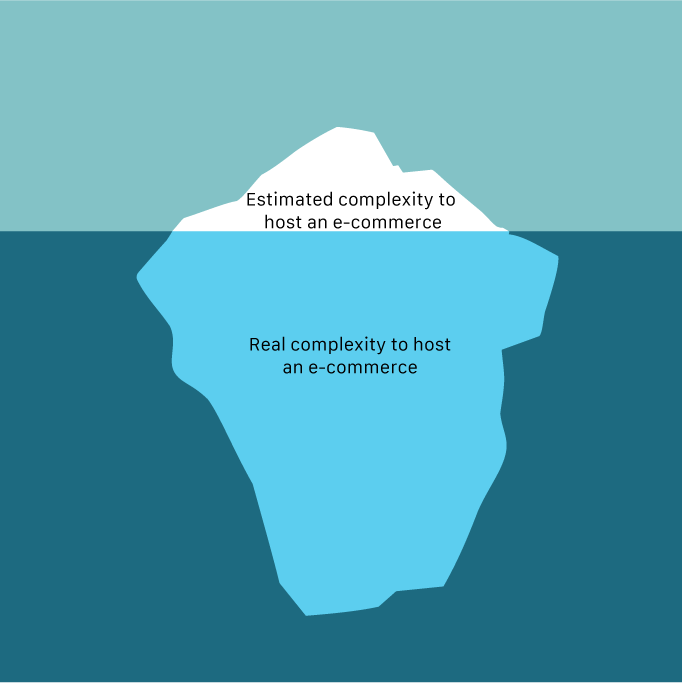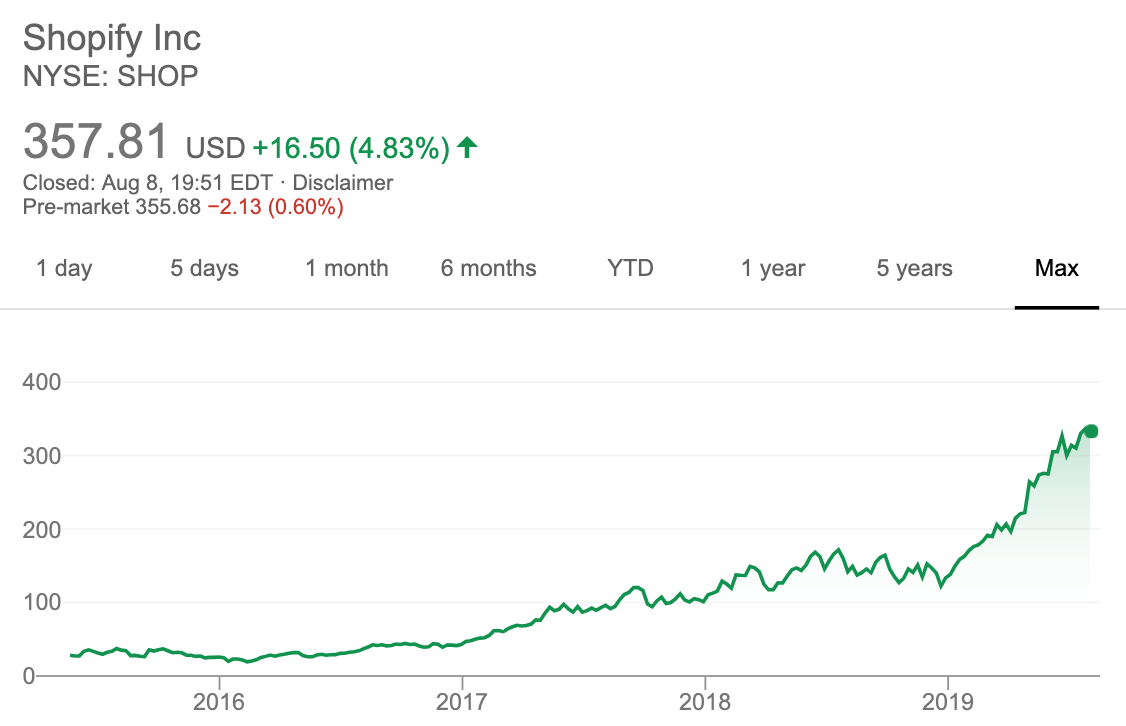Magento vs Shopify
August 27, 2019
Gianluca Chiap
Shopify vs Magento: our take
Magento and Shopify are two of the most popular platforms that can be used today to build an e-commerce. The debate between the flexibility offered by Magento versus the neatness provided by Shopify has not a clear winner yet. Many Shopify vs. Magento posts have already been written, and we are not going into details comparing every single feature since you can find many articles online.
We are going to approach this analysis using a more empirical method, sharing our experience, having worked with both platforms, and explaining why we have eventually decided to go all-in on Shopify.
TLDR;
Both Magento and Shopify will almost surely get you where you want. Magento is an open-source solution, while Shopify it’s a Platform as a Service. You can customize Magento as you wish, adding or removing functionalities. Shopify, on the other hand, does not provide that flexibility, but it provides an ecosystem where you won’t miss much of Magento freedom. Flexibility comes at a cost in terms of complexity, and complexity is the main reason for longer development time and higher costs. The freedom offered by Magento comes at the price of having to manage every aspect of the e-commerce, from hosting, to security patches, to updates.
It’s not always worth to trade simplicity for flexibility, especially for businesses where moving fast is critical for success.
An overview of Magento and Shopify in 175 words.
Magento was first released in 2008. In 2018 it was acquired by Adobe for $1.7bn. It is currently reported to be the n.1 e-commerce platform by volume handled.
Magento offers two variants of its core product:
- Magento Open Source, is a free and open-source version of Magento where it’s possible to customize and extend every functionality.
- Magento Commerce, targeted to enterprise, is a paid version that provides more features and can be run on-premises or as a PaaS, managed by Magento team with a solution called Magento Hosted Cloud.
Shopify was launched in 2006. In 2015 it went public and it currently has a market cap of $35bn. It’s the third e-commerce by volume behind Magento and WooCommerce but it’s growing faster, particularly at the enterprise level. It offers two solutions:
- Shopify, the base product, that comes with different subscription plan.
- Shopify Plus, which provides a higher level of customization and it's targeted to the enterprise. Both solutions are provided only in the form of a Platform as a Service (PaaS).
How to make a fair comparison?
A 100% fair comparison is impossible. A more or less fair comparison could be:
- Shopify vs. Magento Open Source
- Shopify Plus vs. Magento Commerce
Who uses Shopify?
In February 2019, it was reported that more than 800,000 merchants were using a Shopify platform. Some of the famous brand are:

Fun fact
Elon Musk’s Boring Company sold 20.000 flamethrowers in a day using a e-commerce powered by Shopify.

Who uses Magento?
Magento is used by more than 250,00 e-commerce. Some of the most famous brand are:

Flexibility/complexity tradeoff.
Both Magento and Shopify provide all the features needed to manage an e-commerce, like managing products, promotions, shippings, payments, etc.
There is a 99% chance that you can build any e-commerce with both platforms. The difference lies in the effort required to reach the goal
Magento and Shopify have two completely different philosophies: Magento offers a platform as customizable as possible, leaving the final choice about functionalities to developers, while Shopify aims to provide the smoothest possible experience for merchants, with sensible defaults and tips on how to obtain higher performance from the e-commerce.
No platform is intrinsically better than the other. It’s all about which one fits your requirements in the best way
Before making any choice you need to carefully ask the following questions:
- Do you prefer a self managed or PaaS solution?
- If you choose a self managed solution, does your team have the technical knowledge required to build and manage the e-commerce?
- What is your budget?
- What functionality do you absolutely need and what are cool to have?
If you end up deciding for the flexibility offered by Magento you should know that
Flexibility comes at a cost

The flexibility you gain by using a platform like Magento comes at a cost in the form of complexity, and you should ask if it is worth it.
Do you really need that extra flexibility?
Flexibility gives you more freedom at the cost of an increase in the overall complexity. But there is a catch: the initial feeling of freedom provided by having control over every functionality is quickly replaced by the realization to be stuck again by overwhelming complexity.

The hidden costs of flexibility.
Shopify PaaS model does not let you access or modify its source code, and If you like the idea of having complete control over your application, you will probably lean towards Magento.
By using an open-source solution like Magento you can add, remove, or change every feature, to create a product wholly tailored on your needs. But you will also be also responsible for every aspect of the e-commerce.
With great power comes great responsibility
- I’m ok with that, how hard can it be?
- It’s pretty hard.
- Oh, but at least it’s free.
- Weeeeeell, not exactly.
If you decide to go for Magento Open Source hoping to save some money, you will be pretty disappointed, since it's true that Magento won't charge you a penny, but there are a lot of hidden costs that people tend to underestimate.
It’s very uncommon to take into account the opportunity cost when deciding between possible solutions
In this specific case, the opportunity cost can be summarized with:
What could I have done instead of doing that?
You need good technical skills just to build the e-commerce
Magento is a massive project, and the learning curve is quite steep. You need excellent programming skills just to dig into the code and make everything work. If you’re a non-technical person, you will probably end up recruiting a developer team to handle the task.
With Shopify you can publish a new e-commerce immediately, even if you don’t have any technical knowledge.
If you want to go online quickly Shopify is the right choice
Self-hosting
Once you have finished building the e-commerce it’s time to host it, and here things start to get tricky. Self-hosting means taking your website and making it accessible to the public by intalling it on some provider like Amazon Web Services. The server must be able to stand all the traffic while ensuring no data loss or inconsistencies. This is much more complex than what it seems like.

Building an infrastructure from scratch means you have to deal with security, auto-scaling, load balance, database backups, and much more.
Self hosting works great until it doesn’t

Shopify, on the other hand, is a fully hosted solution. It runs on an infrastructure entirely managed by Shopify, and you don’t have to worry about anything.
Security
If you are going to sell anything online, you must follow specific security standard (namely PCI DSS) to protect your customer payment data from being stolen and used in fraud. The reputation of your store is at stake. Are your servers compliant with all those security standards? Do you meet GDPR requirements if you are selling in the EU?

All Shopify applications are hosted PCI Compliance Level 1, the maximum security level. And they are regularly audited. Using Magento (not cloud) you are responsible for the all the security aspects.
Using Shopify, security is one less thing to worry about
fixing bugs and updating
Once you have managed to build and host the e-commerce, there is still tons of work to do. For example, when adding new functionalities or customizing an existing one, there is a good chance of introducing new bugs.
The more functionalities your shop has, the more bugs it can have.

On top of that by using a self-managed solution you are responsible for installing all the patches and security updates released by Magento, paying attention not to break anything in the process.

With Shopify, by giving up some flexibility, you are gaining freedom from dealing with security patches and updates.

Scaling
It’s Black Friday weekend, you have just launched a costly advertising campaign, and users are flooding to your e-commerce. But wait, the servers can’t handle all the requests, and suddenly everything goes down. If you are lucky, users will only get an extremely slow and frustrating experience. Otherwise your e-commerce is no longer reachable.

The risk is that you will be spending more time solving problems about scaling, than actually scaling.
But [insert big brand name] is using Magento and works fine even during Black friday
Yes, but they likely have an entire engineering team just dedicated to that. Can you afford it?
Users don’t care about your e-commerce infrastructure. They want their experience to be as pleasant as possible. It’s challenging to compete against a PaaS in term of scalability, and therefore, you should stop wasting time managing your infrastructure and instead investing your time to create the best user experience possible.
To sum up
There is a clear tradeoff between flexibility and complexity. The more flexible a platform is, the more complicated it becomes. If you want to use Magento you must be sure you’ll be able to handle the complexity.
Otherwise the risk is that you will end up wasting most of your time dealing with problems not directly related to your business, like managing servers, and there is a good chance your store is going to accumulate technical debt over time, leading to a situation where your business is constantly lagging behind competition.
While you are spending time figuring out how to scale your infrastructure or update to the latest version without breaking everything you competitors are implementing new features
With Shopify you can focus on the important things leaving all the management of the infrastructure to Shopify.
A PaaS solution like the one offered by Shopify is stress free
What about Enterprise?
At enterprise level the battle is between Magento Commerce and Shopify Plus. Things become quite expensive (both platforms start at $2000/month) and business processes are very different. We are going to talk about e-commerce at enterprise level in another post.
Why we choose Shopify
Shopify fits our clients’ requirements and developers mental sanity. It can be summarized with:
It just works
You don’t have to worry about infrastructure, and you can invest your time working on optimizing the user experience, which in turn let us focus on what matters to our customers.
Shopify has a great ecosystem
Maybe Shopify does not offer the same freedom of Magento, but its ecosystem won’t make you miss it.
Shopify is much more than just an e-commerce platform. It allows you to manage several aspects of your business, including brick and mortar stores through Shopify POS, shipping with Shopify Shipping, payments with Shopify Payments and more recently even logistics with the announcement of Shopify Fulfillment Network. Moreover Shopify offers a marketplace of plug and play apps for almost any necessities
Shopify is growing fast
We are not the only one to believe in Shopify. If we look at Google Trends we can clearly see Shopify popularity growing while interest in Magento is declining.

Even the markets believe in Shopify. The stock price has gone from $28 to $350 in less than 5 years.

Conclusion
We hope that this post has created some food for thoughts about the flexibility/complexity tradeoff, and why we choose Shopify over Magento.
Of course, Shopify is not a perfect platform, and there are a lot of functionalities and improvements we hope to see in the future, but overall we believe Shopify approach will become the gold standard of e-commerces.
As always if you want to discuss this post, or ask us anything you can find us on Twitter or Linkedin